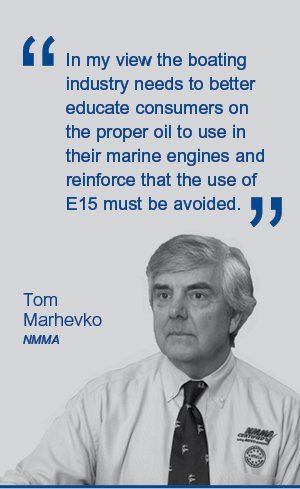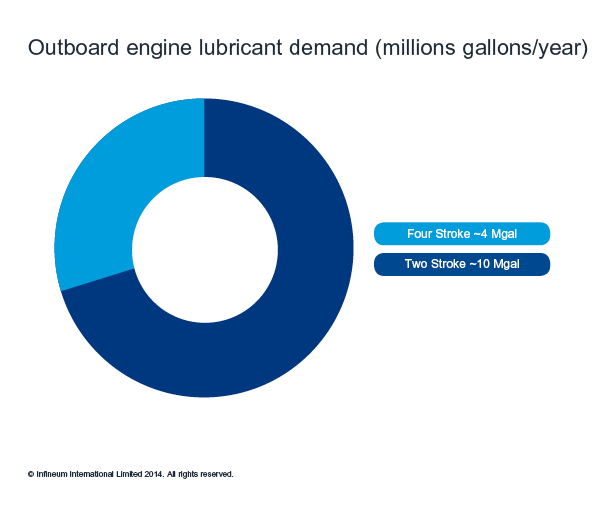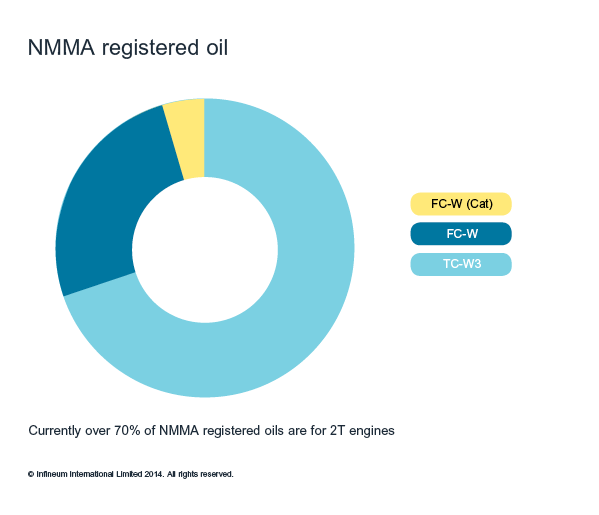Small Engines
Two-wheels rev up
08 July 2025
Please note this article was published in March 2014 and the facts and opinions expressed may no longer be valid.
11 March 2014
Demanding requirements of the growing North American outboard market

Tom Marhevko, Vice President of Engineering Standards at the National Marine Manufacturers Association (NMMA), talks to Insight about two of the current lubricant and fuel issues that can affect water-borne engines.

There is finally some good news in the outboard market, where sales of new and pre-owned boats are on the increase, following a substantial downturn in the recession.
Figures from the NMMA show that the US recreational boating industry saw an estimated 5% increase in new powerboat retail sales last year, and the even better news is that the organisation expects sales to grow another 5-7% in 2014.
Americans are taking to the water in record numbers and are spending more on new powerboats, with retail dollar sales expected to be up 8% in 2013 - signalling that the mix of boats being purchased includes higher priced models.
Our latest figures show that over 37% of the population participated in recreational boating at least once in 2012 – the largest number since we began counting in 1990.
Currently about thirteen and a half million motorised boats cruise the seas, lakes and rivers of North America – logging some 700 million hours on the water in 2011. These vessels generate a yearly demand for an estimated 14 million gallons of outboard engine oils, with 70% being for two-stroke engines.

The continued demand for two-stroke oils reflects the fact that, unlike the motorcycle market, the engine population is transitioning very gradually from two-stroke (2T) to four-stroke (4T) engines. This is partially owing to the durability of older carburetted 2T engines, and the continued use of 2T direct fuel injection (DFI) for high horse power applications. However, this 2T engine weight advantage is diminishing, as lighter 4T engines are being introduced.
“In the last year about 220,000 outboard units were sold around the world. About 15% of those were two-stroke – ten years ago it was just the opposite, with about 15% being four-stroke.”
Tom Marhevko, NMMA
With factory shipments now predominantly 4T engines, lubricant demand for four-stroke FC-W™ and FC-W™(CAT) will continue to increase. However, the overall outboard oil market volume is expected to decline with 4T engines using less oil than 2T engines.
The 2T and 4T engines that power outboards have very different lubrication requirements. In 2T engines, the oil mixes with the fuel and lubricates the engine as it passes through, and is then burned along with the fuel. But, 4T engines are lubricated by oil that is pumped from and returned to a sump.
Despite the differences, the key objectives of OEMs producing these engines are the same: reducing emissions to satisfy EPA requirements, and extending the life of their engines to reduce warranty problems and increase customer satisfaction.
To meet these objectives OEMs have introduced advanced 2T and 4T outboard engine technologies, which place severe demands on engine lubricants.
In response, the NMMA maintains three categories in its lubricant quality certification programme to help boaters choose an oil that will protect the engine throughout its life.
 NMMA certifications are designed to help boaters recognise lubricants that will give the
NMMA certifications are designed to help boaters recognise lubricants that will give the
engine life expectancy designed-in by marine engine manufacturers
“With the increase in the number of four-stroke engines being built and sold in the US, the number of four-stroke licences is increasing almost exponentially every year.”
Tom Marhevko, NMMA
But, the slow transition from 2T to 4T engines is clearly reflected in the NMMA lubricant certifications - where the registration list is dominated by TC-W3, two-stroke lubricants.
“The number of two-stroke licences has remained the same for about the last 10 years, and we think that that is because of the sheer numbers of two-stroke engines used throughout the world. All over Asia there are two-stroke engines 20 and 30 years old that still need two-stroke oil, and we see those licences still being maintained.”
Tom Marhevko, NMMA

Some of the work being carried out by NMMA, Infineum and OEMs is designed to address two key issues currently impacting outboard engine performance:
“In my view the boating industry needs to better educate consumers on the proper oil to use in their marine engines and reinforce that the use of E15 must be avoided.”
Tom Marhevko, NMMA
Water presents one of the largest concerns regarding the protection of outboard engines because, whether it is salt or fresh, it can lead to the formation of rust on engine parts. Passenger car engine oils (PCMOs) are simply not designed to provide the level of rust protection these engines require.
“You might think that you could use a passenger car motor oil in a marine engine, but actually they require specifically formulated oils. Marine engines operate in a high humidity environment, with a lot of water around, and passenger car motor oils have not been formulated to cope in this environment.”
Tom Marhevko, NMMA
But it is not only in their rust prevention capabilities that PCMO formulations fall short of the performance requirements demanded by outboard engines. Because 4T outboard engines run faster than car engines, spend long periods running at the extremes of speed and can spend long periods out of use, they have very specific requirements for improved bearing durability, wear protection and shear stability.
“Boat owners want to turn on their boat and then run across the water at full speed, much different to the way we use a passenger car. So the oil has to accommodate that type of usage, and that is what marine oils are formulated to do.
Tom Marhevko, NMMA
| Leisure marine operating conditions | Formulation requirement | Can PCMO deliver? |
|---|---|---|
| Water | Rust protection | No |
| Fast engine speed | Improved shear stability | Insufficient |
| Long periods at extremes of speed | Bearing durability Wear protection |
Insufficient |
| Aging boat population | Advanced hardware protection | Insufficient |
However, formulating lubricants to deliver all these attributes to outboard engines is not straightforward. It is not simply about maximising performance in all these areas, the lubricant formulator must strike a careful balance between the chemistries designed to provide wear and rust protection because the underlying components compete with each other for the surface of the engine parts.
In our view, this fact alone means it highly unlikely that a PCMO can be formulated to successfully do the job.
Clearly the best advice for boaters who want to ensure they protect their engines is to look for the NMMA logo on the oil they select, and/or use the OEM oil. This is becoming increasingly important as the formulation of oils designed for use in passenger cars moves even further away from the ideal standard required to offer the protection that marine engines need.
Infineum is working with its customers, along with the NMMA, to help inform boaters so that they can make the right lubrication choices.
The second concern facing the recreational boating industry relates to the Renewable Fuel Standard (RFS-2), which requires US fuel to contain 36 billion gallons of renewable fuel by 2022. To help meet these aims, the US Environmental Protection Agency (EPA) has introduced ethanol as an energy saving initiative and an alternative to petroleum-based fuels.
"While the NMMA is not opposed to the use of ethanol as an additive in gasoline, it is concerned that current engines are not designed to be compatible with gasoline containing more than 10% ethanol."
Tom Marhevko, NMMA
Regardless of this fact, the EPA is proposing to change the automotive and light-duty truck certification fuel to E15 (15% ethanol) in its Tier 3 Motor Vehicle Emission and Fuel Standards, which means E15 is expected to become the predominant fuel in the US marketplace in the next 10-15 years.
A series of engine evaluations, conducted by Mercury Marine and Volvo Penta, under the direction of the Department of Energy (DOE) National Renewable Energy Laboratory (NREL), concluded that E15 fuels not only severely damage marine engines, but also cause them to exceed EPA emission standards.
"E15 burns hotter, and in a marine engine this can mean the valves start to crack, what’s more marine engines are just not timed to use E15."
Tom Marhevko, NMMA
The potential for boat owners to accidently use fuel with a percentage of ethanol above 10% will increase significantly if E15 becomes the primary fuel in the marketplace. Current labelling prohibits the use of E15 in engines, other than post 2001 passenger cars, and is mandatory for any retailer who choses to sell the fuel.
“The industry has to get into every consumer’s owner’s manual and annual registration, and tell them not to use this fuel because it is not made for your marine engine - we have to do a better job on our end to do this.”
Tom Marhevko, NMMA
 Labelling and legislation need to change to protect the consumer
Labelling and legislation need to change to protect the consumer While marinas will continue to carry gasoline for marine engines without ethanol, if E15 becomes the most available fuel in the automotive marketplace, misapplication seems inevitable.
Boat owners who misfuel their vessels are unlikely to be covered by their manufacturers’ warrantees.
“Unfortunately, because most boats can go on a trailer, consumers can easily pull into a gas station and fill up the car and the boat at the same time – but it is illegal to put E15 in the boat’s fuel tank because it is not equipped to handle it.“
Tom Marhevko, NMMA
According to the NMMA, there are serious and well-documented human safety, environmental, and technology concerns associated with the use of E15 in recreational boat fuel tanks and engines. This has prompted the organisation to urge the EPA and DOE to appeal to Congress and the President to freeze ethanol at 10%, while neutral party technical evaluation are conducted to assess alternatives that can be introduced at a higher concentrations, without the negative effects of ethanol.
These issues demonstrate how consumer education is becoming increasingly important in the outboard engine industry, as well as in other engine industries, where the lube and fuel requirements continue to diverge. Boaters simply cannot treat their outboard engine in the same way as their car engine.
Sign up to receive monthly updates via email
